The first rule of safe living in an apartment is to hide the cables and cords stretched from electrical appliances to sockets. Designers offer a lot of ideas on how to hide wires so that they do not interfere with moving around the apartment. Power cords can be “drowned” in the walls or it is interesting to beat in the interior, the main thing is to approach the process creatively.
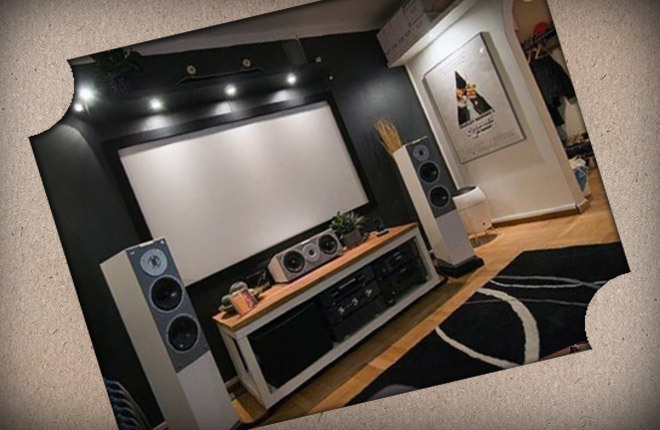
The content of the article:
- The need to mask electrical communications
-
Hiding wires in the wall
- In a concrete or brick wall
- In plasterboard wall
- Floor and ceiling installation
- Skirting boards with cable channels
- Camouflage covers
- Decor with stickers, stickers, improvised means
- Wires as an art object
- We use the wire as an interior detail, style
- How to hide wires from children
The need to mask electrical communications
There are two reasons why you need to hide the wires, put them out of reach, two:
- aesthetic violation. Clews of intertwined cords of different sections and colors create visual noise, violating the integrity of the perception of the situation in the living room, bathroom, hallway, and kitchen. Chaos is especially noticeable in original, stylistically executed interiors. The exception is loft, industrial, techno, art-believe design. Such interiors imply external fastening of wires - “in plain sight”.
- Security breach. Through the interweaving of cords randomly scattered across the floor of the room, it is easy to stumble, fall, or get injured. Crawling babies can chew through a thin wire and get an electric shock. The same applies to pets, which often remain in the apartment unattended.
Hiding wires in the wall
From the point of view of functionality and aesthetics, in order to hide the power cords, it is better to use the method of creating a cable laying pattern and massive wires at the initial stage of construction. It is better to hide the wires with a hidden method, which requires gating the surface.
Power cables, electrical wires are laid in specially made channels, the laying points are covered with a solution. Next, the walls are leveled and prepared for painting or wallpapering. The process is dusty, time consuming and labor intensive. But if the work is done reliably, dangerous wiring can be hidden for a long time, and it will no longer be possible to access it without breaking the wall.
In a concrete or brick wall
It is recommended to fix electrical communications at the very beginning of the repair, and even better at the stage of creating a house layout.
What you need:
- a drill, and if the walls are concrete, then a puncher or a wall chaser;
- lagoon;
- paint brushes, roller, spatulas;
- gypsum powder;
- putty.
To hide wires in a concrete or brick wall:
- Draw up a layout, mark the wiring attachment points.
- Mark the walls with a construction or laser method.
- With a suitable electric tool, cut out the strobes of the desired width and depth.
- Lay the cable, fixing the dowel-clamps.
- A gypsum mortar is prepared, which fills the groove spaces.
- The walls are plastered, allowed to dry, and then the surfaces are leveled.
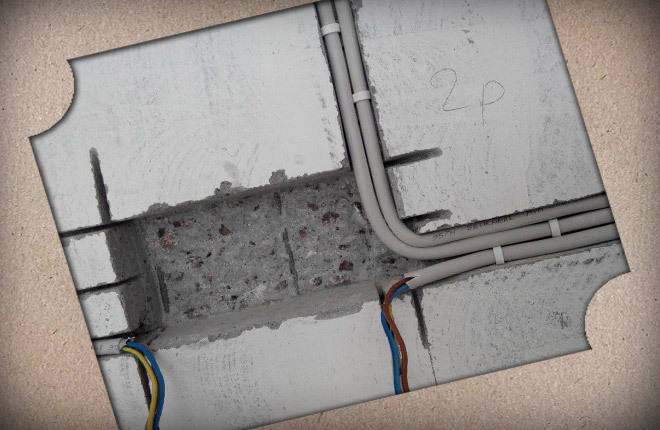
Hidden wiring is laid horizontally and vertically, at a distance of at least 15-20 cm to the upper and lower borders. Attaching cords diagonally is unacceptable according to safety regulations.
In plasterboard wall
It is better to hide the cables in the drywall construction at the stage of finishing work. Compared to installing electrical wiring in a different way, the process creates less difficulties.
The main thing is that the finished system guarantees complete security and provides free access to elements that have been safely hidden.
Drywall sheets are installed with or without a frame. However, the second option is losing popularity, since it is required to ditch load-bearing walls and lay cables inside the grooves. The framework method looks different.
The electrical wiring is fixed on a metal frame to which drywall is attached. The profiles are equipped with holes for plastic ties, but sometimes they are missing, so they are drilled on their own.
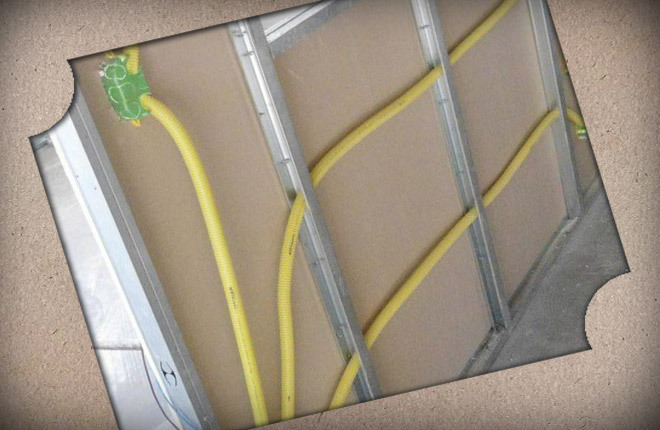
To securely hide the wiring in drywall walls, you need:
- plastic or metal corrugation - for greater reliability, it is replaced with a cable channel;
- power cable of the required length;
- ground wire;
- drill for drilling holes;
- fasteners: clips, bushings, ties.
Procedure:
- A frame is assembled from metal profiles, on the one hand it is sheathed with sheets of drywall.
- Place junction boxes, including for sockets and switches. Then, along the route of laying the wires, clips or clamps are fixed at a distance of 30-40 cm.
- A corrugation is pulled through the holes in the frame, and cables are already passed through it, which lead to the installation sites of switches and sockets.
- Connect the elements and check the circuit. If it works properly, the front side of the frame is sewn up with plasterboard sheets.
Floor and ceiling installation
Fixing electrical wiring to the ceiling is relevant if the bearing surface is completely or fragmentarily covered with drywall sheets, tension structures, plastic or wooden false beams. These coatings hide power wiring, electrical cords from a chandelier, sconce, intercom, and fasteners. It is convenient to hide wires in this way when the repair of walls and floors is already completed, and spoiling a fresh coating (especially highly artistic) is expensive and undesirable.
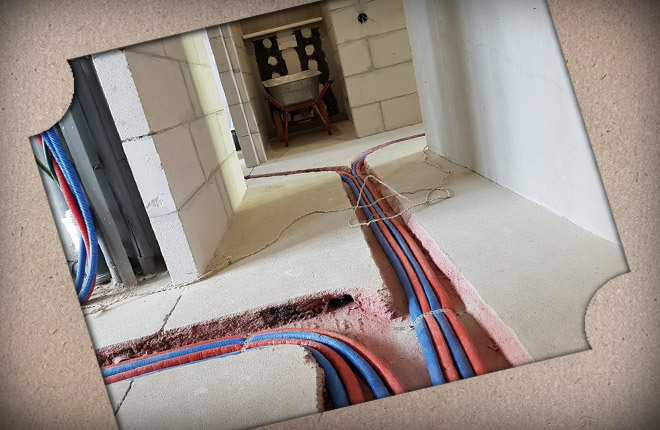
The method of lower electrical wiring to the floor is less costly and convenient, because it is so easy to hide the wiring lines by laying them out according to the diagram and immediately securing them securely. Especially when it is impossible to do this on walls or ceilings for some reason.
You can hide cables in the floor if:
- it is planned to pour a concrete screed with a height of at least 6 cm;
- minimize the number of electrical wires that will be connected to the junction box;
- competently draw up a diagram in which the overlap of power lines is not provided;
- a large cross-section cable with self-extinguishing insulation will be used, passed through protective pipes or corrugations.
The lower electrical wiring is chosen if you need to install sockets and switches at a minimum height from the lower boundary. Lay the wires at a distance of 20-30 cm from the edge. To do this, use a flexible perforated tape, textiles, mesh.
Skirting boards with cable channels
Universal structures for laying low-voltage and power cables can be installed on any surface: ceiling, walls, floor. The interior of certain models is divided into sections, which allows you to safely hide the wires.
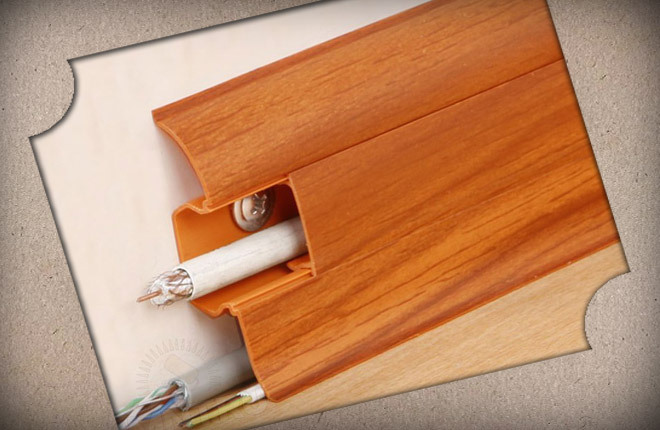
Advantages of the cable channel:
- Beauty. The designs have different designs and colors, so they are suitable for the interior and flooring.
- Free access to communications. This means easy, hassle-free repairs and upgrades to wiring.
- High degree of protection. Due to the reliable design, the box protects against moisture ingress, which reduces the risk of a short circuit.
- Fire resistance. If a short circuit occurs, the material of the box will contain the spread of fire, which means it will prevent a fire.
- Flexibility. Thanks to this ability, electrical communications are fixed on inclined, curved, hemispherical surfaces.
- Ease of fastening. No need to cut strobes in the walls, and then close up the grooves.
Camouflage covers
This method of disguising wiring is most often suitable when you need to hide an extension cord with chargers for gadgets, headphones, USB cables. Budget camouflage covers in the form of wall organizers or envelopes can be knitted or sewn from any suitable material: fabric, leather, thick oilcloth. Design and size options are easy to find online. This will help to properly store the necessary accessories and keep them always “at hand”, for example, in a drawer or chest of drawers.
Some stores offer decorative collapsible covers made of safe plastic in the form of multi-colored tubes, shiny snakes, tree branches. The designs allow you to safely hide the wires, although they do not have such protective properties as cable channels.
Some manufacturers of accessories for electrical engineering produce protective covers in the form of a braid - they have an aesthetic appearance and fit into any interior. Depending on the internal diameter, one or several electric cords can be hidden in them.
The braid is easy to tie with your own hands. To do this, plastic bags are cut into thin identical strips, which are interconnected and wound into a reel. A kind of “sleeve” of the desired length is knitted from them with knitting needles or crocheted.
Decor with stickers, stickers, improvised means
If it is not possible to hide the wires from the equipment using one of the methods described above, they can be bring to the wall, ceiling and securely fasten with decorative elements.
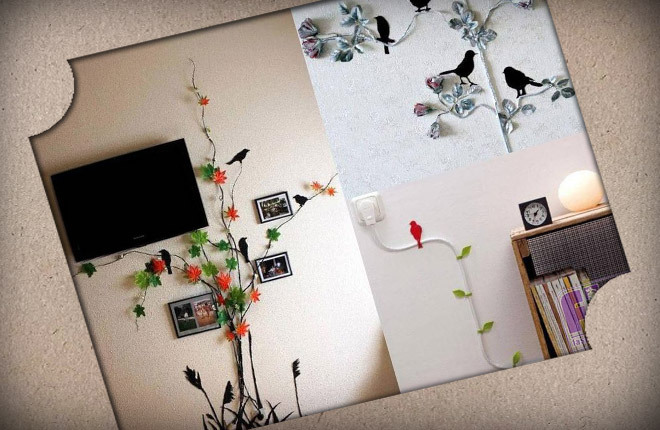
Stickers, stickers, plastic holders and even stationery clips are sold almost everywhere, and they are also quite inexpensive. If you approach the solution of the problem creatively, you can not only visually hide the wires, but also create a unique composition.
The best and practical options:
- Decorative clips. These elements are a great way to hide long cords that get in the way. Stylish or, conversely, multi-colored clips will help you lay the wires on the wall in the form of a pattern or geometric figure, put them around the doorway.
- Colored tape. If the wires cannot be hidden, they can be wrapped with multi-colored electrical tape. The main thing is to choose a shade that will be in harmony with the color scheme of the interior. So that the decor does not turn out to be aggressive, “flashy”, too bright tones should be avoided.
- Beads. They can be strung on power cords if they are not too thick. In order for the elements to fit, when choosing, you need to pay attention to the middle - the hole must have a large diameter. As in the previous case, it is better to choose beads of those shades that fit perfectly into the interior. You can string monophonic products or combine several harmonizing shades at once.
- Rope. Jute or hemp will perfectly help to hide wires in an eco-style interior. The rope is evenly wound around the cables, stitching tightly, and then fixed to the wall with transparent clips. If planters with fresh flowers are suspended from the ceiling, the wrapped wires can be stretched between them by throwing them over a hanging cord.
- Stickers and stickers. Too long cables and wires can also be "hidden" on the wall, fixed with transparent clips. And if the shade of the braid of the cords contrasts with the color of the surface, it is better not to mask it, but to beat it with decorative stickers or stickers. To do this, showing a little imagination, you need to come up with an original composition, and lay it out using wires. Then they will attract attention, but as a work of art.
- Decorative clamps. Such decorative elements today can be bought in all stores. They are a flexible clip, decorated with flowers, leaves, butterflies, birds, sparkles, feathered, which allows you to hide the wiring in the living room, bedroom, nursery, kitchen and even the bathroom room.
- Panels or curtains. This option is suitable when you need hide the wires from the TV, consoles, soundbar, home theater. As a decor, you can use ordinary wooden or soft wall panels. By attaching two decorative elements to the wall at once, you can hide the wires, but at the same time highlight the entire area. In some interiors, panels can be replaced with curtains. Textile elements are hung on mini cafe cornices, which are easily attached to the wall.
Wires as an art object
From a cable of great length, contrasting in color with the wall, it is easy to lay out the original outline image. If the wires are long enough, trees, silhouettes of people and animals, furniture and household items, city panoramas are laid out with their help.
In the interiors of industrial or loft styles, it is also easy to hide the wires by laying bricks, electric lamps, corrugated pipes, intricate geometric shapes out of them.
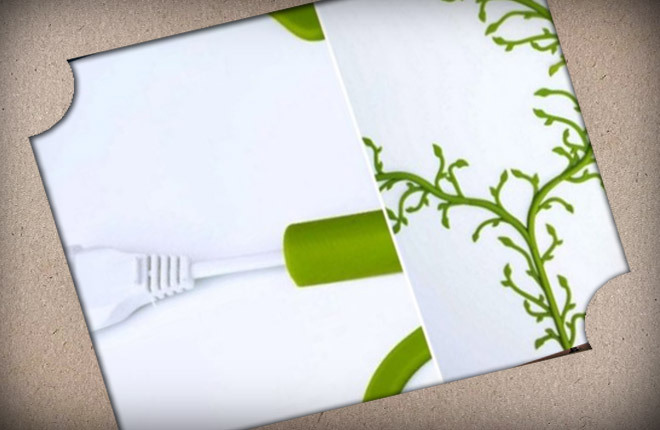
Multi-colored electric cords can repeat the pattern on window curtains, wallpaper, parquet, complement fragments of wall painting, imitate the missing fragments of a complex structure.
We use the wire as an interior detail, style
The most specific interior design style is the loft. In such rooms, you do not need to think about how to hide the wires, since you need to emphasize and play with their fastening. Today, outdoor wiring in the "retro" style, which can be seen in houses built in the last century, is becoming more and more popular.
Given the high demand, electrical wiring companies offer:
- wires imitating aged silver;
- twisted electrical cords of copper color, ivory brass;
- sockets of an unusual shape, stylized "antique";
- ceramic insulators for fastening wires;
- convex wall retro switches.
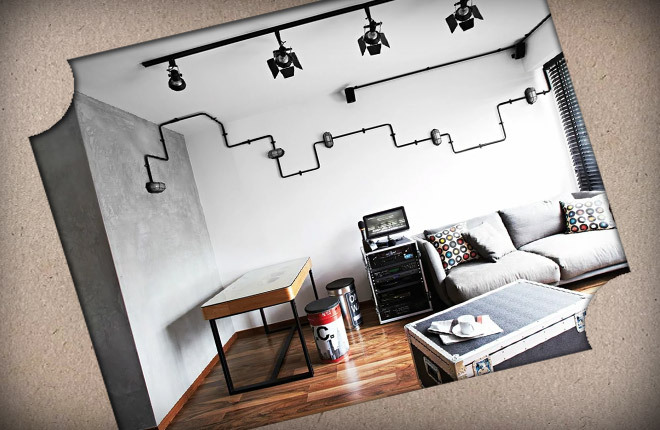
Loft interiors most often have open wiring, however, fire safety rules must also be observed here. Therefore, over time, it is better to hide it.
How to hide wires from children
Cables, power cords not only spoil the appearance of the interior, but also pose a serious danger to the little inhabitants of the apartment. Many companies produce lines of protective elements, devices designed to hide wires and protect children from electric shock. Among the popular:
- Electrical fasteners. Made of durable material, they withstand strong mechanical stress, but at the same time they are roomy and allow you to hide from 2 to 4 cords.
- Plastic or cardboard boxes, fabric bags-cases. They easily hide extension cords, part of the electrical wires.
- Special integrated devices for charging mobile devices, office equipment, which are easily integrated into any furniture surface.
For individual devices, it is advisable to use simple wireless designs that can be placed out of reach of children.
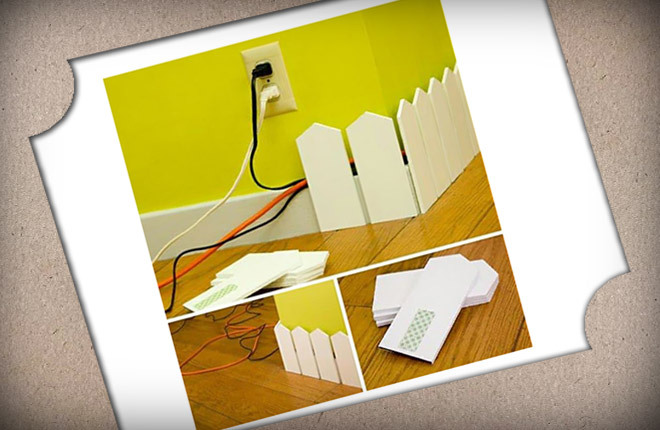
If the child is forced to stay at home alone, he should not:
- independently turn on or turn off electrical appliances;
- approach separately lying wires, cords, cables;
- remove plugs from sockets;
- play in close proximity to home electrical equipment;
- touch the surface of electrical equipment with wet hands, and even more so wash or wipe them with a damp cloth;
- remove protection from household appliances, connect or disconnect wires, replace light bulbs, fuses, perform other repairs.
Wireless technology is becoming popular, but not yet widely used, so most electrical appliances are still powered by AC and wall outlets. An excellent solution to protect the lives of family members and maintain the attractiveness of the home is to securely hide the wires that stick out from all corners. Our recommendations will help to do this without difficulty and large investments.
We have described the most interesting options that will help you quickly hide wires from audio and video systems, computer, office equipment, kitchen electrical appliances, securing the room and visually improving the view interior. Bookmark the article, share it on social networks, on thematic forums. Write in the comments about other interesting methods that allow you to hide electrical communications, we will definitely discuss them.


